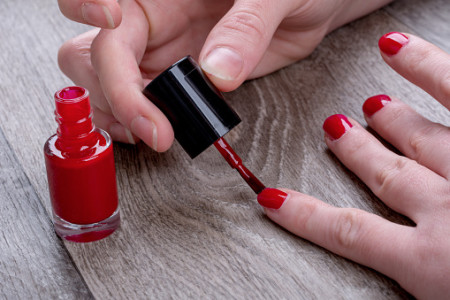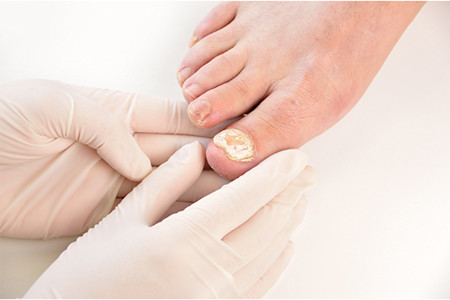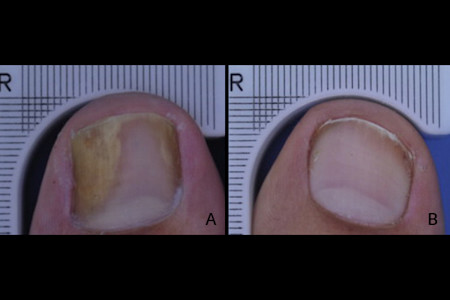Nail fungus: Diagnosis and treatment
Dermatologists understand that people can be hesitant to seek care if they could have nail fungus (medical name onychomycosis). Treatment takes time. Some patients have concerns about taking medications due to possible side effects.
When creating a treatment plan, dermatologists tailor treatment to the needs of each patient. Your dermatologist will consider your health, whether you have any other medical conditions, what medications (if any) you take, how much nail(s) is affected, and the type(s) of fungus causing the infection. This allows them to develop the safest and most effective plan.
Are you hiding an infected nail with nail polish?
Be sure to ask your dermatologist if you can wear nail polish while treating nail fungus.

How do dermatologists diagnose nail fungus?
To diagnose nail fungus, your dermatologist will:
Examine both your fingernails and toenails, checking for color change, buildup beneath a nail, and other signs of nail fungus.
Ask about your health.
Ask questions to find out if you were exposed to nail fungus, such as at home or at a gym or pool.
Your dermatologist may also take a sample from a nail. To do this, your dermatologist can remove some buildup from a nail, clip off a bit of the nail, or scrape a nail’s surface. What your dermatologist removes will be looked at under a microscope.
This microscopic view helps to make sure that you have nail fungus. Another nail condition, such as nail psoriasis or a nail injury, sometimes looks like nail fungus.
Depending on the tests ordered, this close-up view can also help your dermatologist select the best treatment should you have nail fungus.
How do dermatologists treat nail fungus?
The goals of treatment are:
Get rid of the fungal infection.
Restore the nail (when possible), so that it looks like your unaffected nails.
Keep in mind that nails grow slowly, so treatment takes time.
Tell your dermatologist if you are pregnant, planning to become pregnant, or are breastfeeding.
Some treatments should not be used during pregnancy or while breastfeeding.

A treatment plan for nail fungus may contain one or more of the following:
Prescription medication you apply to the nail
All these medications kill fungi on the surface of the nail. To make treatment more effective, your dermatologist may file down the surface of the nail, so the medication can penetrate more deeply.
Your dermatologist may prescribe this type of medication if you:
Have mild (and sometimes moderate) nail fungus
Are 60 years of age or older
Children tend to have better results with this type of medication than adults because children’s nails grow faster.
Topical (applied to the nail) medications that dermatologists prescribe include:
Efinaconazole 10% solution: The U.S. Food and Drug Administration (FDA) has approved this prescription medication to treat toenail fungus in patients 6 years of age and older.
Treatment involves applying efinaconazole once a day at home, usually for 48 weeks. If you find it difficult to use this medication for as long as prescribed, tell your dermatologist. To clear the infection, this medication must be applied for as long as prescribed — even if your symptoms begin to go away.
Tips for best results:
Apply this medication every day to the infected nail and its cuticle, the skin around the nail, and the area beneath the nail.
When applying, make sure the skin around the nails and the nails are clean and dry.
Wait 10 minutes after showering, washing your feet, or getting your feet wet for any other reason before you apply this medication.
Possible side effects are mild. The most common are ingrown toenail and irritated skin around the nail, which may cause swelling or itching.
Brand names: Clenafin, Jublia
Tavaborole 5% solution: This prescription medication is FDA approved to treat toenail fungus in patients 6 years of age and older.
Treatment involves applying tavaborole once a day at home, usually for 48 weeks. To help completely clear the infection, continue to use this medication for as long as prescribed — even if your symptoms begin to go away.
Before (A) and one year after treatment with tavaborole (B)
This patient applied tavaborole daily for 48 weeks.

Tips for getting the best results:
Apply tavaborole every day as prescribed to clean, dry nails.
Entirely cover each infected nail and beneath each infected nail.
Possible side effects are mild. The most common are skin peeling, an ingrown toenail, or irritated skin where you apply the medication.
Brand name: Kerydin
Ciclopirox nail lacquer: This prescription medication is used to treat nail fungus on both fingernails and toenails in people 12 years of age and older.
For this medication to work well, it’s important to remove any loose nail on the infected nail(s) before you begin applying the medication. Your dermatologist may trim the nail(s), or you may be shown how to do this at home.
Sometimes, this trimming should be performed by a doctor who specializes in diagnosing and treating nail conditions, such as a dermatologist. If your dermatologist needs to trim the nails, you’ll return to your dermatologist’s office as often as once a month to continue having any unattached, infected nail removed.
You’ll also need to remove previous coats of this medication from the nail(s) once every 7 days. You’ll be shown how to do this using rubbing alcohol.
Tips for best results:
Apply the lacquer once a day to the infected nails, covering the entire nail as well as the skin on either side of and beneath the nail.
Some patients prefer to apply this medication before bed, as you need to wait 8 hours after applying it before taking a shower or getting your feet wet.
If you don’t apply before bed, wait 30 seconds before putting on your socks or shoes.
Remove the lacquer once every 7 days, using rubbing alcohol.
Trim the infected nail(s) as instructed (either returning to your dermatologist or trimming the nail(s) yourself).
Possible side effects include an ingrown nail, pain, and irritated skin, such as swelling, burning, or itching, where you applied this medication.
Brand names: Ciclodan, Loprox, Penlac
Treatment to help soften nails
Urea cream or ointment: Studies show that softening thick nails can improve the results you get from topical (medication applied to the nail) treatment. To soften affected nails, your dermatologist may prescribe an ointment or cream that contains 40% urea. You would apply this as directed.
Prescription medication that works throughout the body
If you need more aggressive treatment, your dermatologist will prescribe medication that you take. One of the following oral (take by mouth) medications may be part of your treatment plan. All are antifungal medications that can stop nail fungus from growing.
Terbinafine: Available by prescription, this antifungal is prescribed to treat adults with nail fungus on their fingernails and toenails.
Before you take this medication, you will need testing to see how your liver is functioning. You’ll need to repeat this test 6 weeks after you start taking this medication. Liver damage is a possible, but rare, side effect.
If your dermatologist prescribes terbinafine, you’ll take a pill every day. When treating fingernails, patients take this medication for 6 weeks. To treat nail fungus on toenails, patients take terbinafine for 12 weeks.
While the fungal infection will go away in 6 to 12 weeks, it will take a year or longer for your nail to completely grow out. Until the nail grows out, you’ll see discoloration and other signs of nail fungus – even after the fungus clears.
While taking this medication, you’ll need to not drink alcohol and stay out of the sun.
Be sure to tell your dermatologist if you are pregnant, planning to become pregnant, or breastfeeding. Treating a fungal nail infection can usually wait until after you’ve had your baby. Terbinafine passes into breast milk, so it’s not to be taken while breastfeeding.
Possible side effects tend to be mild and include headaches, rashes, and gastrointestinal symptoms like bloating, decreased appetite, nausea, and diarrhea.
Brand name: Lamisil
Can you use non-prescription terbinafine cream (Lamisil) to treat nail fungus?
No. The terbinafine that you can buy without a prescription is a cream. It’s used to treat fungal infections on the skin, such as athlete’s foot and jock itch. While this cream can effectively treat the skin, it cannot treat nails. To treat nail fungus, the medication must penetrate the nail. Terbinafine topicals used to treat skin infections cannot do this.
Because terbinafine is such an effective medication, dermatologists and other doctors are studying a topical form of terbinafine that can penetrate nails with fungus. One day such a product may be available in the United States.
Itraconazole: The prescription antifungal medication is FDA approved to treat nail fungus in adults. It can treat both toenails and fingernails.
Itraconazole should not be taken if you’re pregnant, as it can harm your baby. It’s also important to know that itraconazole can interact with many other medications, including statins.
It’s important to tell your dermatologist the following:
If you are pregnant, plan to become pregnant, or are breastfeeding
Medications you take, including non-prescription medications
Supplements you take
Medical conditions you have, including heart disease
Before you take this medication, you will need testing to see how your liver is functioning. While rare, liver damage is a possible side effect.
If itraconazole is right for you, you will take the medication daily. Be sure to take it with a full meal.
To treat toenails, you will take it once a day for 12 weeks. If you are treating fingernails, you’ll take the medication daily for 1 week, stop for 3 weeks, and take it again for 1 week.
While taking this medication, you must stay out of the sun and not drink alcohol.
Brand names: Sporanox, Sporaz
Procedures dermatologists use to treat nail fungus
Nail procedures are performed during an office visit. A procedure can improve the results you see from another treatment. Occasionally, a procedure is used to treat nail fungus.
If your dermatologist includes a procedure, your treatment plan may include one or more of the following:
Nail abrasion: This medical procedure involves scraping or filing the surface of one or more nails. This can be helpful if you have a type of nail fungus called white superficial onychomycosis. With this type of nail fungus, the fungi develop on top of the nail, so it may be possible to treat it by scraping the infected nails and applying antifungal medication.
Don’t try to scrape white discoloration from your nails at home. This is a medical procedure that involves experience and practice to do safely, as well as the right tools.
Nail trimming: This is exactly what it sounds like. Your dermatologist trims away any infected nail. This can make it easier for treatment to work and reduces how much fungi you have.
Nail debridement: This is a medical procedure. Dermatologists use it to reduce nail thickness. This can be helpful when treating nail fungus because fungi can thicken nails.
To reduce nail thickness, your dermatologist uses a tool to remove extra layers of toenail. Reducing the thickness can make treatment for nail fungus more effective. Less thickness can also make it easier for you to trim infected nails, walk, and comfortably wear shoes.
Microdrilling: To perform this medical procedure, your dermatologist uses a drill that looks like a pen to make holes in your nail. The micro holes are too tiny to see.
Drilling can let medication that you apply to a nail to get into the tissue beneath the nail. Studies show that this can improve how well the nail clears.
Nail avulsion: This procedure is used to remove your entire nail or part of it. Your dermatologist may recommend this procedure if other treatments for nail fungus fail. Removing some or all the infected nail can cure nail fungus. It can also relieve pain due to the infection.
One type of nail avulsion is a surgical procedure. During this procedure, your dermatologist will surgically remove as much of the nail(s) as needed.
Another type of nail avulsion is called chemical avulsion. This involves your dermatologist applying a chemical called urea to the diseased nail and covering it with a bandage. You leave the bandage on for 7 to 10 days, taking care to keep it dry the entire time. After 7 to 10 days, you return to your dermatologist’s office so that your dermatologist can remove the treated nail.
With both types of nail avulsion, you will need to care for the treated area at home to prevent infection and control pain. Your dermatologist will give you instructions for at-home care.
Nails usually grow back, but this takes time. If an entire fingernail is removed, it can take 6 months or longer to regrow. Toenails can take 12 to 18 months to regrow.
Lasers are not FDA approved to treat nail fungus
The FDA has approved laser treatment to improve the look of a nail after the fungal infection has cleared. It has not approved any laser to treat the infection. If you’re thinking about getting laser treatment to treat discoloration or other signs of nail fungus, it’s important to keep in mind that insurance doesn’t normally cover the cost of this treatment. Insurance companies consider clearing the nail that’s already been cleared of the fungus a cosmetic treatment.
Dermatologists and other researchers are studying whether lasers and other light-based treatments can also safely and effectively get rid of nail fungus. Early studies show promise. However, well-designed clinical trials are needed to find out which lasers can provide safe and effective treatment.
Can tea tree oil or a cough-suppressing ointment cure nail fungus?
You may have heard that rubbing tea tree oil or a mentholated cough-suppressing ointment on your nails can cure nail fungus. These home remedies have been talked about so often that patients often ask about them.
Given that many patients have asked about these options, dermatologists have run small studies. Turns out, there may be some benefits. However, the studies run to date have been small. We still don’t know how effective they are and what possible side effects could occur. Larger studies are needed to answer these and other questions.
What is the outlook for people who have nail fungus?
With a dermatologist’s help, nail fungus is highly treatable. Keep in mind, it takes time to treat nail fungus. Sometimes, it takes time to find the right treatment for a patient.
To get the best results from treatment, it’s essential to use treatment as directed and keep all follow-up appointments.
It’s also important to know that nail fungus can return after clearing. This can occur a year or more after clearing. If you see signs of nail fungus, make an appointment to see your dermatologist. These doctors have experience with treating recurrences (the medical term for returning). The sooner returning nail fungus is treated, the better the outcome.
Prevention can keep you one step ahead of nail fungus
Once you’ve had nail fungus, you have a greater chance of developing another fungal nail infection. For this reason, your dermatologist may prescribe treatment that you apply at home after the infection clears. This type of treatment is called maintenance therapy.
Maintenance therapy involves using treatment to prevent another infection. For example, to maintain infection-free nails, your dermatologist may prescribe medication that you apply to your nails. You may need to use this for a year or longer.
Maintenance therapy can be especially helpful for patients who have another medical condition like diabetes, damaged arteries or veins, or a nail injury.
Dermatologists also give their patients tips for preventing another infection. To see what dermatologists recommend, go to 11 tips to prevent nail fungus.
Images
Images 1, 2: Getty Images
Image 3: Used with permission of the Journal of the American Academy of Dermatology
J Am Acad Dermatol 2015;73:62-9.
References
Elewski BE, Aly R, et al. “Efficacy and safety of tavaborole topical solution, 5%, a novel boron-based antifungal agent, for the treatment of toenail onychomycosis: Results from 2 randomized phase-III studies.” J Am Acad Dermatol. 2015 Jul;73(1):62-9.
Falotico JM, Lipner SR. “Updated perspectives on the diagnosis and management of onychomycosis.” Clin Cosmet Investig Dermatol. 2022 Sep 15;15:1933-57.
Kreijkamp-Kaspers S, Hawke K, et al. “Oral antifungal medication for toenail onychomycosis.” Cochrane Database Syst Rev. 2017 Jul 14;7(7):CD010031.
Leung AKC, Lam JM, et al. “Onychomycosis: An updated review.” Recent Pat Inflamm Allergy Drug Discov. 2020;14(1):32-45.
Lipner SR, Scher RK. “Onychomycosis: Clinical overview and diagnosis.” J Am Acad Dermatol. 2019 Apr;80(4):835-51.
Stewart CR, Algu L, et al. “Effect of onychomycosis and treatment on patient-reported quality-of-life outcomes: A systematic review.” J Am Acad Dermatol. 2021 Nov;85(5):1227-39.
Written by:
Paula Ludmann, MS
Reviewed by:
William Warren Kwan, MD, FAAD
Shari Lipner, MD, PhD, FAAD
Temitayo Ogunleye, MD, FAAD
Last updated: 6/26/25
 Atopic dermatitis: More FDA-approved treatments
Atopic dermatitis: More FDA-approved treatments
 Biosimilars: 14 FAQs
Biosimilars: 14 FAQs
 How to trim your nails
How to trim your nails
 Relieve uncontrollably itchy skin
Relieve uncontrollably itchy skin
 Fade dark spots
Fade dark spots
 Untreatable razor bumps or acne?
Untreatable razor bumps or acne?
 Tattoo removal
Tattoo removal
 Scar treatment
Scar treatment
 Free materials to help raise skin cancer awareness
Free materials to help raise skin cancer awareness
 Dermatologist-approved lesson plans, activities you can use
Dermatologist-approved lesson plans, activities you can use
 Find a Dermatologist
Find a Dermatologist
 What is a dermatologist?
What is a dermatologist?